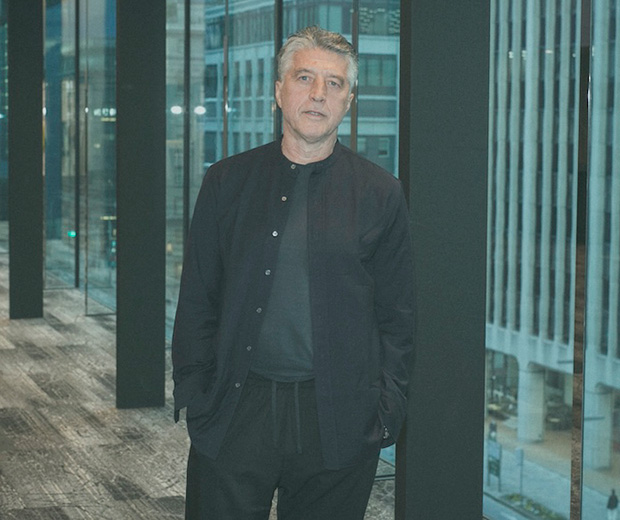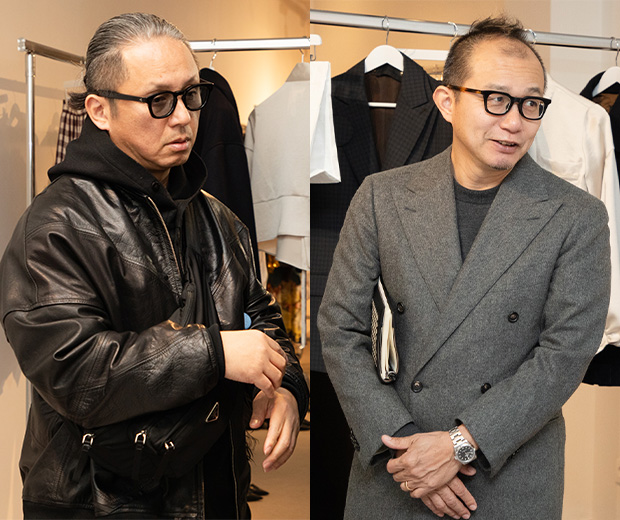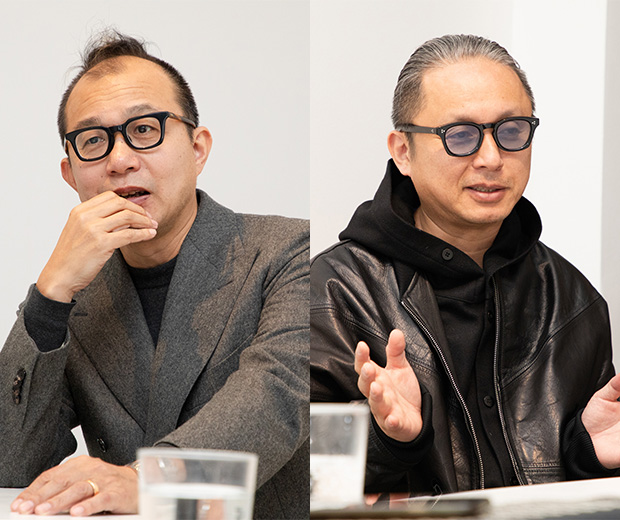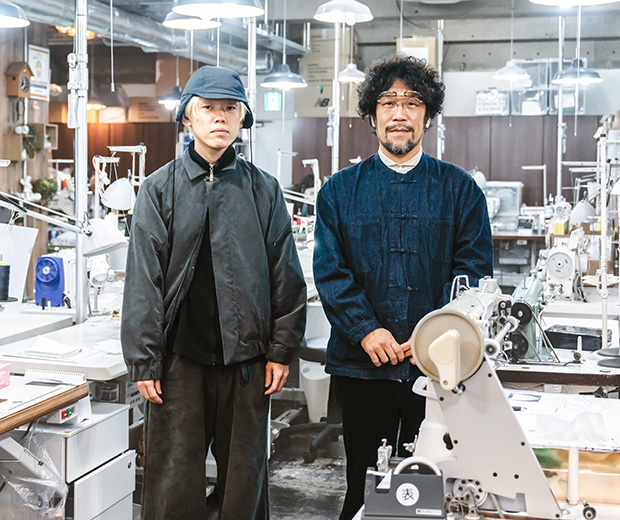JUN OKAMOTO
After traveling to France by himself and launching his own brand, Jun Okamoto returned to Japan in 2010 and has been gaining fans ever since. By replacing seasonal themes with one’s own “story” Jun Okamoto aims to create clothes that enable the wearer to project their own thoughts and memories. He will participate in the coming Mercedes-Benz Fashion Week TOKYO 2013 S/S for the first time. Jun Okamoto has been gaining much attention and was selected as a recipient designer by Japan’s first fashion fund “Fight Fashion Fund” sponsored by Parco
Why did you want to become a fashion designer?
My mother ran an order-made clothes shop in Kumamoto. So I knew that there was such a profession as a fashion designer, but I never went to my mother’s workplace. Thereafter when I was in high school I saw the Paris Collection on TV and finally learned what it was that designers do. After graduating from high school, I entered Bunka Fashion College. But at the time I didn’t know about other professions, such as pattern making and MD, and just kind of fell into becoming a designer.
Tell me how you wound up going to France.
I first went to Paris for a study tour during design school. I would go to the Picasso Museum and see lots of elementary school kids sitting in front of his works listening to someone who I assumed to be a teacher. I was blown away to see these children sitting in front of the actual works of Picasso, something that we Japanese only see in books, and listening to the teacher, I felt the urge to live there myself. After graduation from Bunka Fashion College I studied at Studio Bercot in Paris and then launched my own brand in Paris in 2005, after working as an assistant for Alexandre Matthieu.
What was it like to study abroad in France by yourself and run your own brand there?
The most important thing I learned while going to school there is that you must enjoy fashion yourself no matter what you do. No matter how good your creations are, if you walk around looking like you’re wearing pajamas no one’s going to look at your work. I liked how everyone was enjoying their own natural style. What’s more, you see people that don’t have a lot of money but still enjoy their lives and their work. I think the reason why I was able to start my own brand by myself without knowing whether or not it would be profitable is because I was in this environment that allowed me to create something personal. But while that was a good thing, on the other hand I felt like I was doing something with a small group of friends that really wasn’t taking off in many senses.
Is that why you moved back to Japan?
Yes. A little while after I had started my brand I began holding exhibitions in Tokyo, and it was very stimulating to be an environment where I would say something and the people around me would actually work to make it happen. At the time I felt I belonged completely to Paris, which was relaxing and very comfortable, but I felt like no matter what I talked about it all faded into the background. I wasn’t being stimulated anymore.
Did moving back to Japan change your creations?
In Japan there is no discrimination between the clothes you wear on a daily basis and those that you would wear to a party or dinner, and it all has style to some extent. That’s where the culture in Paris is different, which has caused a change in my perspective. It’s difficult to explain, but when I was making things in Paris I laid it all out on the table, but now when I make something here in Japan I’m more reserved. When designing in the past I had this image of a woman like those seen in a Helmut Newton photograph, but since coming to Tokyo I have turned more to designing real clothes and when I design I imagine that the person wearing them is the main character in a story that I’m creating.
For the 2012 S/S season you released a collection based on three stories, “Breakfast, Champagne and Froth on the Daydream” right?
Amidst a world overflowing with various things, recently I think that awareness towards buying clothes has become a little sloppy. So I thought if you have a piece of clothing with a story or memory, then that clothing would be different from all the rest. It was with this vision that I decided to write a story using literary works that I like. I wanted to make clothes that could have a personal attachment for each person as if to say, “Those clothes were worn in the scene from that story”. Up until now I had been thinking of themes for each season, but I felt like I was contradicting myself because the clothes that I make don’t change that much.

2012-13 A/W collection based on the theme of “Breakfast, Champagne and Froth on the Daydream”

2012-13 A/W collection based on the theme of “Bouquet, Magic, Glenn Gould”
How do you blend a story into your clothes?
The story is created at about the same time as the clothes. I create the fabric or a certain texture in order to materialize the words and scenes that I think of, and let it be reflected in the details. This time around I imagined a story where there were a thousand balloons lifting off of a field of flowers and each balloon carried with it a dream and memory. During the last show I used a lot of balloons to convey an image of a field of rape blossoms but I was really passionate about not letting it end there.
This will be your first time participating in Mercedes-Benz Fashion Week TOKYO.
I’ve already been contacted by people overseas and I get the feeling that the number of people that come to see the show is increasing at an overwhelming pace. I’m not the type of person that plans far in advance for the brand but rather captures the best things from the choices in front of me and then scrambles to get things done. And that’s exactly what’s happening this time. Just like when I participated in the Fashion Fund, I only became aware of the scale of the project after I started (laugh). But I feel like if I think too much about it in the beginning, I might become scared and paralyzed as a result.
Did you discover anything through your new experience with the Fashion Fund?
When I heard that Parco was going to be establishing Japan’s first fashion fund I applied simply because I thought it would be interesting. Since a fund implies that you will be borrowing money I had to get all my numbers together to show them, which was good experience because up until then I had been doing everything by myself and management of my numbers was a little loose.
Did your creative process change?
Yes. Since I have investors, I no longer feel like I am alone. It was kind of like having homework over summer vacation; I now feel like I need to do a little bit everyday (laugh). On the cost side of things, I used to make what I like and then the price for the clothing was decided after it was finished, but recently I started thinking of how a 100 yen change in the price of textiles will be reflected in the retail price. I also feel like my participation in the fund has enabled me to meet and speak with more people, such as people from Parco, and that has led to other new challenges.
Could you tell me a little bit about the semi-custom order line shop “wallflower by jun okamoto” that opened in Kumamoto last year?
At the store, customers can look through pattern samples of JUN OKAMOTO and choose the fabric and extend the length etc. My mother is still running an order made shop but the skill involved with order made clothes is completely different from ready-to-wear clothes, but I’d like to inherit the skill. I usually decide on shaping fabric and then mass-produce my clothing, but colors are not limitless so there are restrictions. But since the customers that come to the shop are looking to create a piece of clothing for themselves, I’m often surprised when I see their finished creation because I hadn’t thought of doing it that way.

「wallflower by jun okamoto」(Kumamoto)
So it’s like collaborating with your customers to make a creation?
Yes. With my brand I don’t want to just change the style and have young people wear it all the time; I would rather grow with the customer and make clothes that are not just consumed but rather reflect emotions and memories of each and every one of them. Hopefully by unveiling my creations at Mercedes-Benz Fashion Week TOKYO I will be seeing more customers of that nature both in Japan and overseas. Wherever the place, I want to go beyond a mere client-customer relationship; rather, I hope to create a relationship as collaborative partners.
Through an assistant of Alexandre Matthieu, started his brand based in Paris in 2005. In 2011, opened his first shop "wallflower bu jun okamoto" in his hometown, Kumamoto.
He makes a sample with sheeting mainly on the pattern of the archive, also offers the pattern order system of choosing cloth which he purchased in Europe, original by JUN OKAMOTO and his select. He was chosen as one of two designers of "FIGHT FASHION FUND sponsored by Parco which is the fund in the first Japanese fashion in January, 2012.





